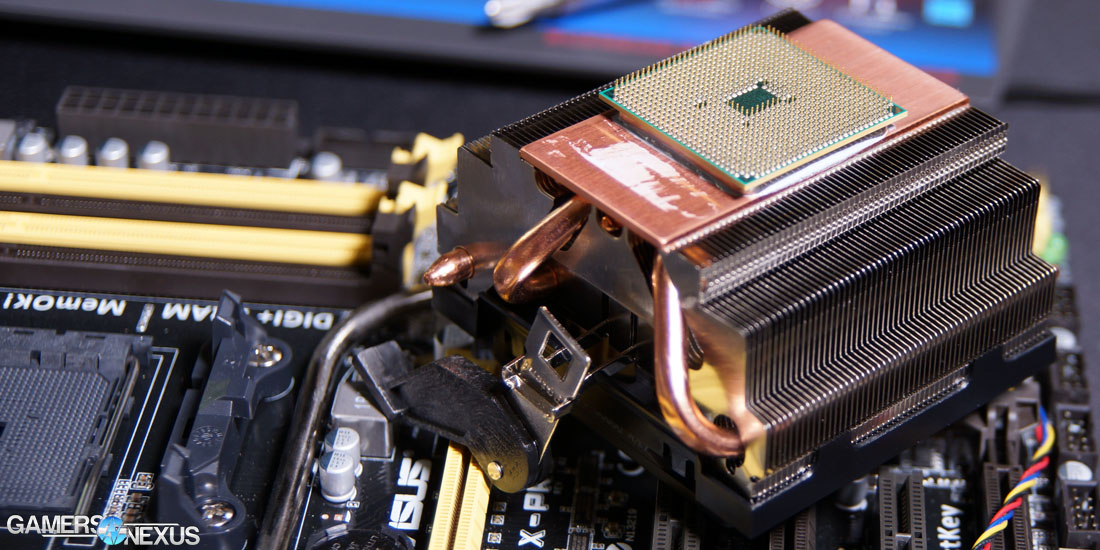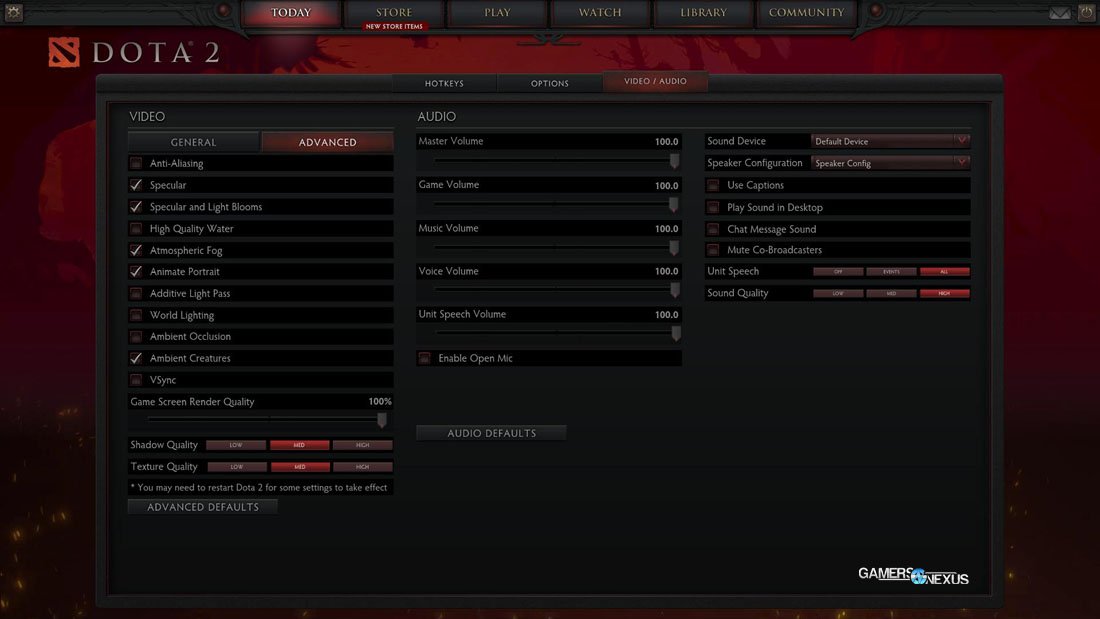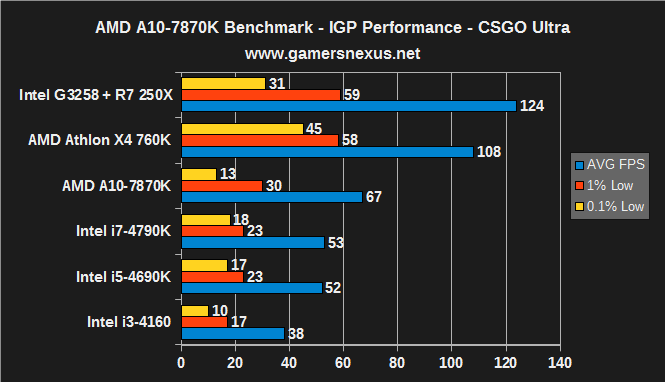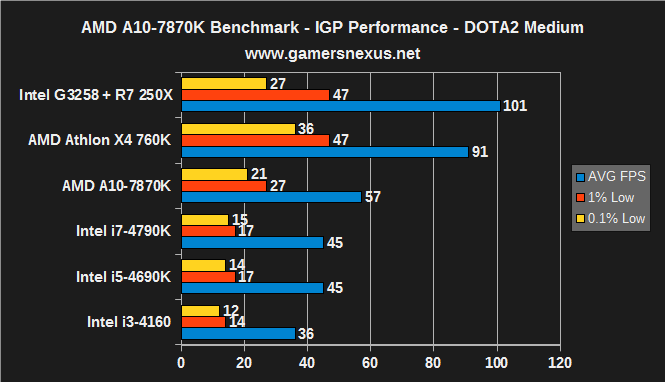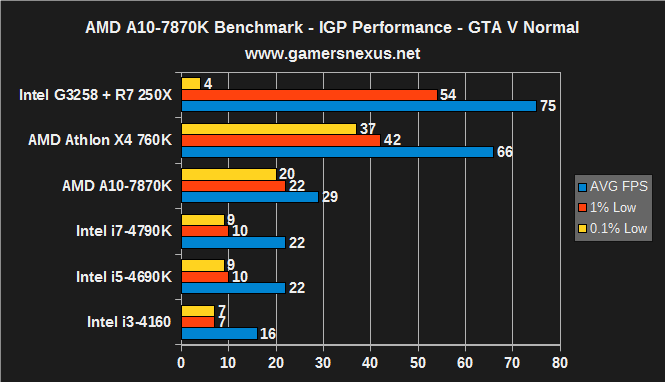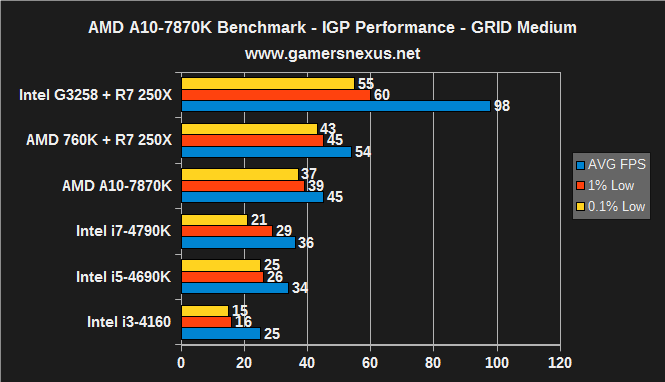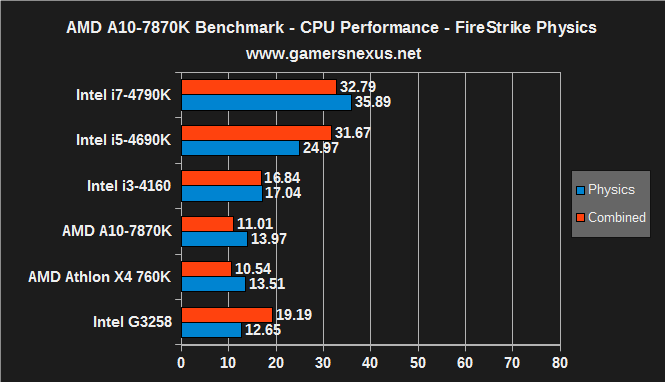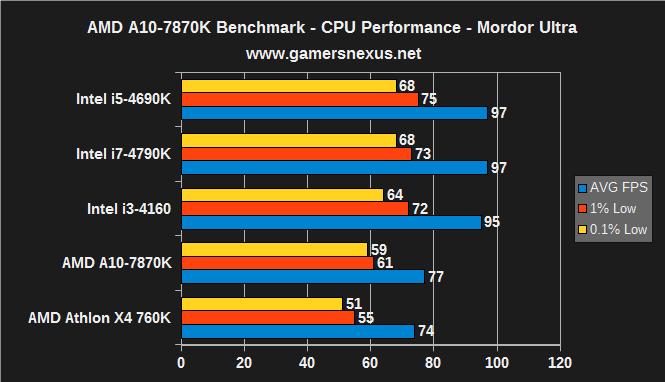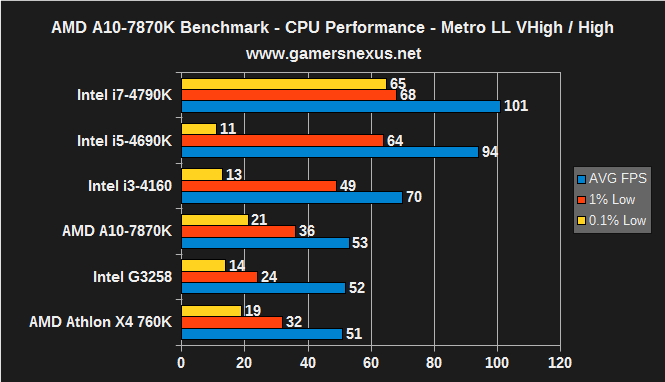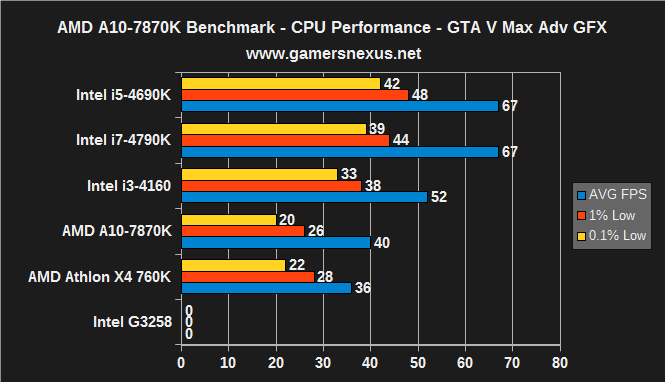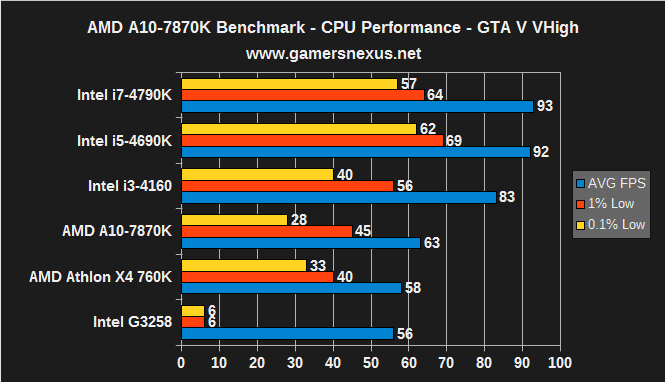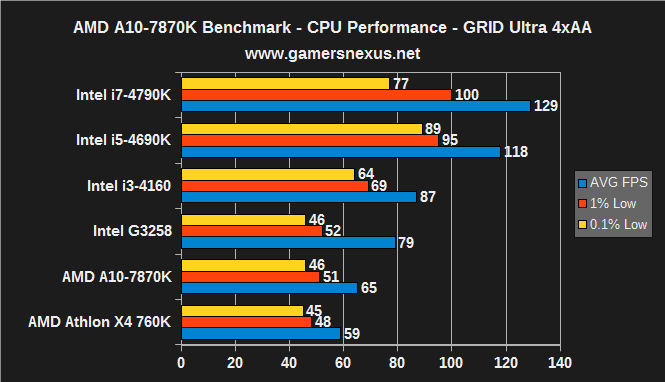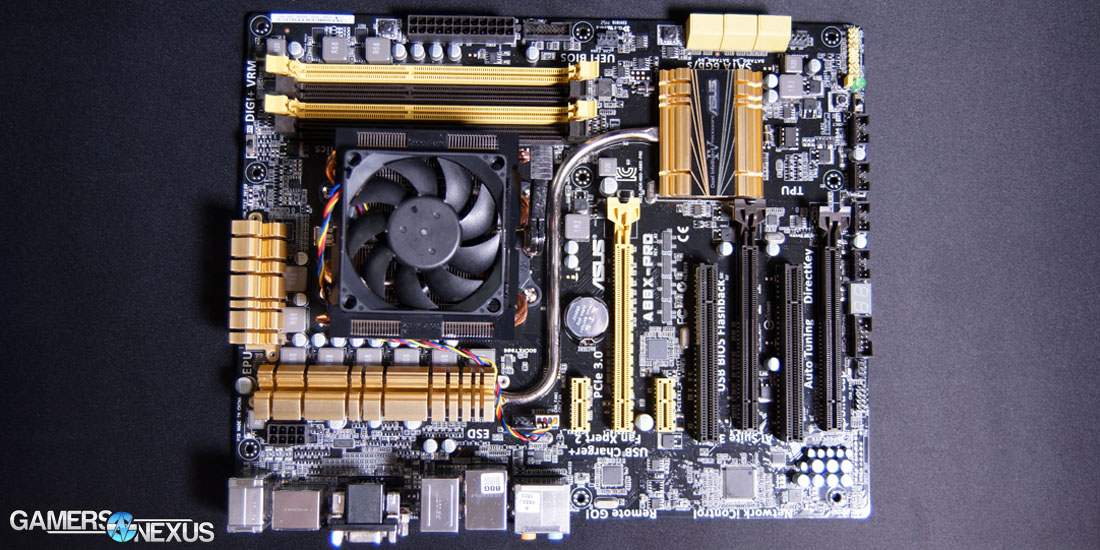After an extended period of hardware silence, AMD has recently made its resurgence with updated GPU and CPU lines. The Radeon 300 series refreshed the existing R200 lineup, followed shortly by the architecturally revamped Fiji GPU on the Fury X; we've reviewed both of these launches (R9 390 & 380 review / Fury X review). Back in May, we also posted about the company's promised Kaveri refresh – the A10-7870K – and its market positioning.
Today we're reviewing that APU.
The A10-7870K APU is built on the Kaveri architecture and refreshes the A10-7850K, mostly by way of small frequency boosts to the CPU and GPU. This AMD A10-7870K review compares the APU against budget CPU + GPU purchases – like the G3258 – and Intel's own HD 4000 series IGPs.
AMD's A10-7870K is priced at $150 at most retailers. Note that, at the time of this review, Amazon is selling the A10-7870K for $122 as a “daily deal.” Pricing will return to $150 once the day has concluded.
We understand that AMD's market positioning and target may differ in Asiatic countries. This review strictly looks at the product from a US / Western perspective, where the price structure of competing and ancillary products is more familiar.
AMD A10-7870K Specs
| A10-7870K | A10-7850K | A10-7700K | |
| COMPUTE Cores | 4 CPU + 8 GPU | 4 CPU + 8 GPU | 4 CPU + 6 GPU |
| Frequency | 4.1 / 3.9GHz | 4 / 3.7GHz | 3.8 / 3.4GHz |
| L2 Cache | 4MB | 4MB | 4MB |
| GPU Frequency | 866MHz | 720MHz | 720MHz |
| Feature Support | Dx12, HSA, FreeSync, Unlocked | Dx12, HSA, FreeSync, Unlocked | Dx12, HSA, FreeSync, Unlocked |
Changes from the A10-7850K
The A10-7870K reflects similar feelings to the R300 refresh. It's not a new architecture, but there are some small changes instituted to the existing platform. As with the R300 vs. R200 references, we would consider the 7870K a “refresh” to the 7850K; that is, it's not a true “rebadge” – the selling of an existing product under a new name – but isn't entirely new, either. There is no inherent flaw with refreshing a product as long as the new price and feature updates reflect progress. Most companies, even non-electrical manufacturers (like those who make cases and coolers), will refresh products between cycles.
AMD's 7870K has increased the CPU frequency from 4GHz / 3.7GHz (turbo / standard) on the 7850K to 4.1GHz / 3.9GHz (turbo / standard) on the 7870K; that's a 0.2GHz pre-overclock. The GPU frequency is slightly more noteworthy, increasing from 720MHz to 866MHz. The rest is the same – Dx12, HSA, and FreeSync are all supported on both the 7850K and 7870K. The 7870K still hosts 4 CPU and 8 GPU cores.
AMD's Kaveri platform hosts Steamroller, for those who recall the now-aging Bulldozer / Piledriver / Steamroller nomenclature. The architecture remains heavy on COMPUTE and arithmetic (integer) processing. Steamroller drove IPC performance more heavily than its power-focused predecessor, Piledriver. Kaveri hosts 2.41B transistors on a 245mm^2 physical die package, using 28nm manufacturing process.
Kaveri's programming model allows developers to tap into its heterogeneous system architecture (HSA) for more equal loading of the coupled CPU and GPU components. The CPU and GPU are able to jointly access most sets of data in the same memory locations, theoretically allowing for co-processing in a fashion that accelerates applications. This is something that must be optimized for in the codebase and is not necessarily a “free” performance improvement.
Test Methodology
We tested using our updated 2015 GPU test bench, detailed in the table below. Our thanks to supporting hardware vendors for supplying some of the test components.
The latest AMD Catalyst drivers (15.7.1) were used for testing. NVidia's 353.62 drivers were used for testing. Game settings were manually controlled for the DUT.
Testing was split between CPU bottleneck analysis and IGP benchmarks. To test at what point the CPU bottlenecks a high-end GPU, we equipped all platforms with a GTX 980 Ti and performed tests using the following settings:
- Metro: Last Light - Very High w/ high tessellation.
- GRID: Autosport - Ultra, 4xMSAA.
- Shadow of Mordor - Ultra preset.
- GTA V - Very High / High.
- GTA V - Very High / High with Advanced Graphics (to find bottlenecks).
- FireStrike (normal).
IGP testing was performed with a lower-end set of games due to limitations on the on-die GPU:
- CSGO - High / Very High with AA disabled.
- GRID: Autosport - Medium.
- DOTA2 - Medium on the sliders, other settings as below.
- GTA V - Lowest (normal).
- FireStrike (normal) for physics.
All tests had the resolution set to 1080p.
Each game was tested for 30 seconds in an identical scenario, then repeated three times for parity.
Average FPS, 1% low, and 0.1% low times are measured. We do not measure maximum or minimum FPS results as we consider these numbers to be pure outliers. Instead, we take an average of the lowest 1% of results (1% low) to show real-world, noticeable dips; we then take an average of the lowest 0.1% of results for severe spikes. Anti-Aliasing was disabled in all tests except GRID: Autosport, which looks significantly better with its default 4xMSAA. HairWorks was disabled where prevalent. Manufacturer-specific technologies were used when present (CHS, PCSS).
Here is the Intel test bench:
| GN Test Bench 2015 | Name | Courtesy Of | Cost |
| Video Card | GTX 980 Ti | NVIDIA AMD | - |
| CPU | Intel i7-4790K CPU Intel i5-4690K CPU Intel i3-4160 CPU Intel G3258 CPU | CyberPower GamersNexus GamersNexus GamersNexus | - |
| Memory | 16GB 2133MHz HyperX Savage RAM | Kingston Tech. | $300 |
| Motherboard | Gigabyte Z97X Gaming G1 | GamersNexus | $285 |
| Power Supply | NZXT 1200W HALE90 V2 | NZXT | $300 |
| SSD | HyperX Predator PCI-e SSD | Kingston Tech. | TBD |
| Case | Top Deck Tech Station | GamersNexus | $250 |
| CPU Cooler | Be Quiet! Dark Rock 3 | Be Quiet! | ~$60 |
And the AMD bench:
| GN Test Bench 2015 | Name | Courtesy Of | Cost |
| Video Card | GTX 980 Ti | NVIDIA AMD | - |
| CPU | AMD A10-7870K AMD Athlon X4 760K | AMD GamersNexus | - |
| Memory | 16GB 2133MHz HyperX Savage RAM | Kingston Tech. | - |
| Motherboard | ASUS A88X-PRO | GamersNexus | $285 |
| Power Supply | NZXT 1200W HALE90 V2 | NZXT | $300 |
| SSD | HyperX Savage SSD | Kingston Tech. | TBD |
| Case | Top Deck Tech Station | GamersNexus | $250 |
| CPU Cooler | Be Quiet! Dark Rock 3 | Be Quiet! | ~$60 |
Continue to page 2 for the benchmark results!
AMD A10-7870K R7 Performance vs. G3258, 760K + 250X – CSGO
AMD's APUs have seen a retargeting of late toward eSports titles, which famously front lower-fidelity graphics in favor of highly performant gameplay. To this end, the 7870K is marketed most heavily as an affordable solution for the likes of CSGO and DOTA2, two wildly popular Valve eSports titles.
For these tests, we had CSGO's settings maxed-out (anti-aliasing disabled) to high / very high settings. The resolution was 1920x1080, as in all tests conducted on the 7870K.
It is clear that the lone A10-7870K is capable of maintaining a playable average FPS >60, though we see hits to performance in the 1% lows (30FPS) and 0.1% lows (13FPS). Coupling a lower-end CPU (G3258, 760K, 860K – not listed) with a low-end GPU still outputs superior performance, though requires a greater power envelope. There are some games where a lower-end CPU combination proves sub-optimal, as we'll find momentarily, but CSGO benefits greatly from a dGPU. The game is not particularly processor-intensive.
Intel's HD4600 IGP outputs impressive performance, having generally straggled behind AMD's integrated graphics solutions. The IGP is just shy of the desired 60FPS range. AMD designates a significantly larger portion of its die to the GPU components of its APUs, though, and is something that should be reflected in our CPU-targeted charts.
AMD A10-7870K R7 Performance vs. G3258, 760K + 250X – DOTA2
We tested DOTA2 with the sliders set to “medium” and other qualities as defined above.
The 7870K runs just shy of 60FPS in this ESL tournament match. The scene tested represents a worst-case scenario, with several heroes and mobs on screen simultaneously. There is a substantial performance improvement from the CPU + cheap dGPU solutions.
As in other tests, the 760K exhibits performance gains over the G3258 strictly in the territory of the low metrics, where the limited threading capabilities of Intel's dual-core solution show themselves.
AMD A10-7870K R7 Performance vs. G3258, 760K + 250X – GTA V
Set to “normal” across the board and with AA disabled, GTA V does what we've seen it do in the past – it kills the G3258. This chart reinforces our dedication to measurement of frame variance over the period of testing.
Despite a chart-topping average FPS performance, the G3258 ($65) + R7 250X ($96) get destroyed in the 0.1% lows, something we've seen consistently when testing modern, heavily threaded titles. The dips are shown through semi-frequent (a minimum of twice per 30-second period) and hard “drops” in framerate. This is a good example of where a 760K or modern 860K, despite lower average performance, would actually be the better processor.
But we're not reviewing either of those CPUs today.
The A10-7870K is, plainly put, entirely unplayable when faced with GTA V even at its lowest settings. At 1080p, it is simply not realistic to expect a fluid framerate in GTA V on AMD's best APU.
AMD A10-7870K R7 Performance vs. G3258, 760K + 250X – GRID
GRID: Autosport was set to “medium” for IGP tests, but changed for CPU testing.
The 7870K is just shy of a preferred 60FPS, but is playable at 45FPS with its impressively consistent 1% and 0.1% lows. Dipping to “low” settings would allow playable gaming with GRID: Autosport. GRID is a title that was heavily supported by Intel at launch, featuring items like self-shading smoke and other Intel-only features, and expresses significantly bolstered performance on the G3258 over the 760K.
AMD A10-7870K CPU Performance vs. G3258, 760K, i3-4160 – FireStrike Physics
The FireStrike Physics test is almost entirely loaded on the CPU, making for a solid baseline analysis tool of CPU rankings from raw gaming-related processing. The combined test merges physics and graphics processing elements to hammer both the CPU and GPU.
The numbers are represented as FPS output of the physics processing passes. Note that all tests used a GTX 980 Ti as the AIB.
The 7870K performs well for an APU, but is only marginally better than AMD's significantly cheaper CPU-only 760K / 860K solutions. This is because the 860K processors are effectively the same part as the 7870K, but ship with the IGP disabled.
AMD A10-7870K CPU Performance vs. G3258, 760K, i3-4160 – Shadow of Mordor
There's some CPU-bottlenecking going on in Shadow of Mordor, as shown below:
The i3-4160, a more CPU-heavy ~$116 solution, has a ~20 AVG FPS gain over the A10-7870K when both are equipped with a GTX 980 Ti.
AMD A10-7870K CPU Performance vs. G3258, 760K, i3-4160 – Metro
Metro: Last Light heavily favors CPUs with higher thread counts, something we'll show in an unrelated forthcoming test.
The i7-4790K + GTX 980 Ti show supremely advantaged 1% low and 0.1% low performance over Intel's own 4690K, a highly performant CPU with hyper-threading disabled. This performance hit extends through the i3-4160 and A10-7870K, both coupled with the same GPU.
The i3-4160 is advantaged again over the A10-7870K, with a ~20 AVG FPS gain. When both are equipped with a dGPU, the A10-7870K shows no reasonable performance gain over a CPU-only solution from AMD.
AMD A10-7870K CPU Performance vs. G3258, 760K, i3-4160 – GTA
Performance in GTA V was measured using two types of settings – very high / high with “advanced graphics” disabled, and the same, but with advanced graphics enabled.
The G3258 fails miserably with higher settings for GTA V, producing unplayable lows at “Very High” and crashing with advanced graphics. The 7870K bottlenecks hard compared to the i7 and i5 CPUs (which seem to hit a GPU bottleneck at ~67FPS).
The game is playable using a dGPU and 7870K with no advanced graphics enabled. The CPU is still a large bottleneck to the GPU when compared against Intel's Core-series offerings, including the i3.
AMD A10-7870K CPU Performance vs. G3258, 760K, i3-4160 – GRID
GRID, again, shows a heavier Intel bias than some other test titles.
The 7870K, G3258, and 760K are all guilty of bottlenecking the GTX 980 Ti (and so is the i3-4160, though to a lesser degree at 87FPS vs. 65FPS AVG).
AMD A10-7870K Conclusion
First: Note that we are analyzing the A10-7870K strictly from a gaming perspective. Results in professional applications and video media consumption were not recorded or tested.
We can come to a few very clear, hard conclusions with the A10-7870K APU; those conclusions are split between “will buy a dGPU” and “will not buy a dGPU.”
For users who intend on using a mid-range-or-better video card with their CPU, there is no reason to purchase an A10-7870K. It is outperformed by the cheaper i3-4160 ($116) in all walks of gaming. We can effectively rule-out the A10-7870K in this use case.
When looking at lower-end video cards, like the deprecated R7 250X at ~$96, it still makes more sense to couple the solution with either an AMD CPU-only Athlon X4 or Intel G3258. Looking over the charts, it becomes clear that the G3258 struggles hard with some new games when it comes to 1% and 0.1% performance, making the 860K ($75) a wiser purchase going forward. An R7 250X or similar + G3258 would run a total of ~$161, or $11 more than the retailer-wide A10-7870K pricing for significantly more versatile performance. An 860K + R7 250X would cost closer to $170, which is getting to be a bigger difference – but still worth the $20.
It isn't until we eliminate video card purchases that the A10-7870K becomes appealing, and that's somewhat expected. The current $150 price-point of the A10-7870K means that it's dangerously close to CPU + GPU pricing at the low-end. For users building ultra-portable boxes in impossibly small enclosures – I can think of very few that exist without AIB support – an APU makes more sense as it removes the requirement of an expansion card. If the pricing of the A10-7870K falls and stays at the current one-day sale price of $120, we can make a much stronger case for the purchase of a single-unit APU over the dGPU + CPU combo; that price drop would create a ~$30 to $50 gap in build cost, which becomes substantial to budget builders.
We're impressed with the performance of the 7870K's IGP, but struggle to recommend the device to most gamers at its current pricing given the CPU + GPU price similarity. It is advisable to avoid the G3258 in scenarios involving heavily threaded games (like GTA V), so we'd then suggest an 860K + low-end GPU instead; if that ~$20 to $30 price climb is too big, the 7870K makes sense. If the 7870K were to fall and stay at the ~$120 mark, we would confidently recommend the unit for ultra-budget builds. This also helps (albeit marginally) lower the power envelope.
DOTA2 and CSGO performance is strong enough that only a 7870K will suffice in unmodded scenarios, if you really want to avoid a dGPU.
- Steve "Lelldorianx" Burke.
